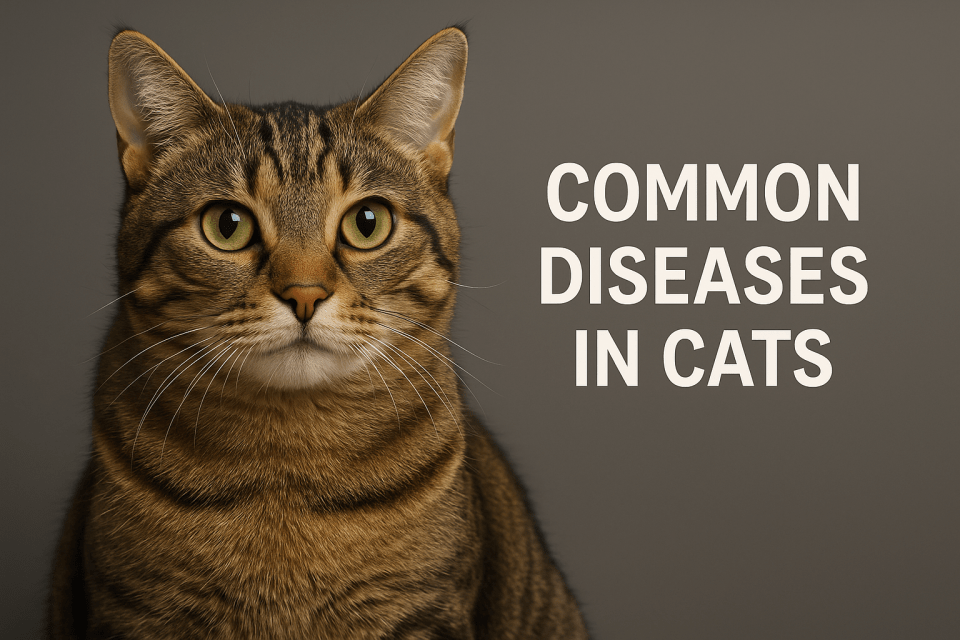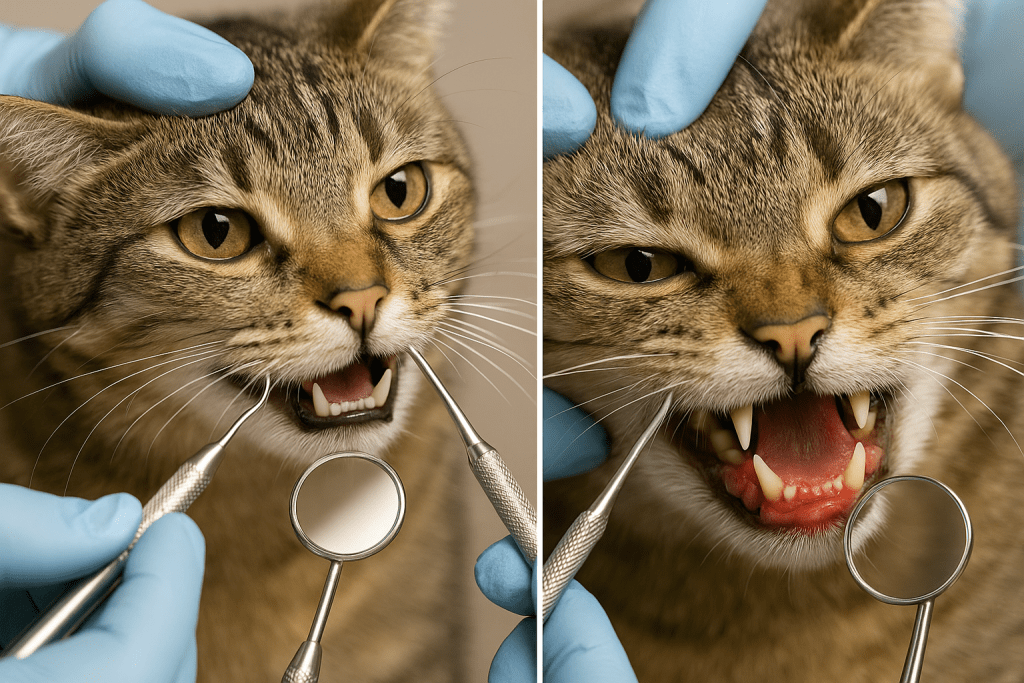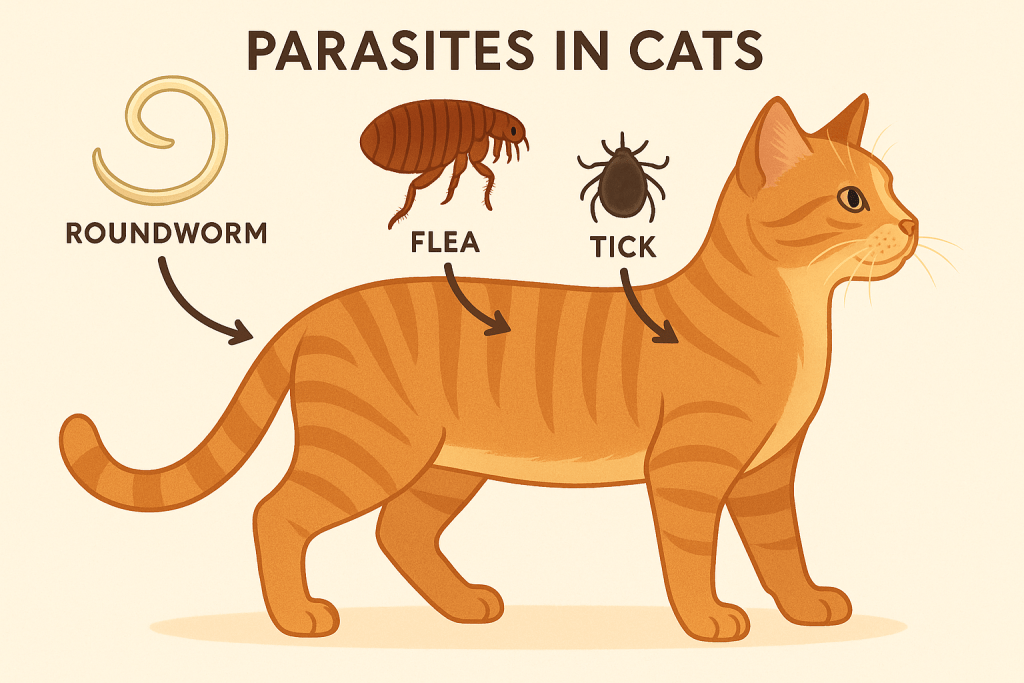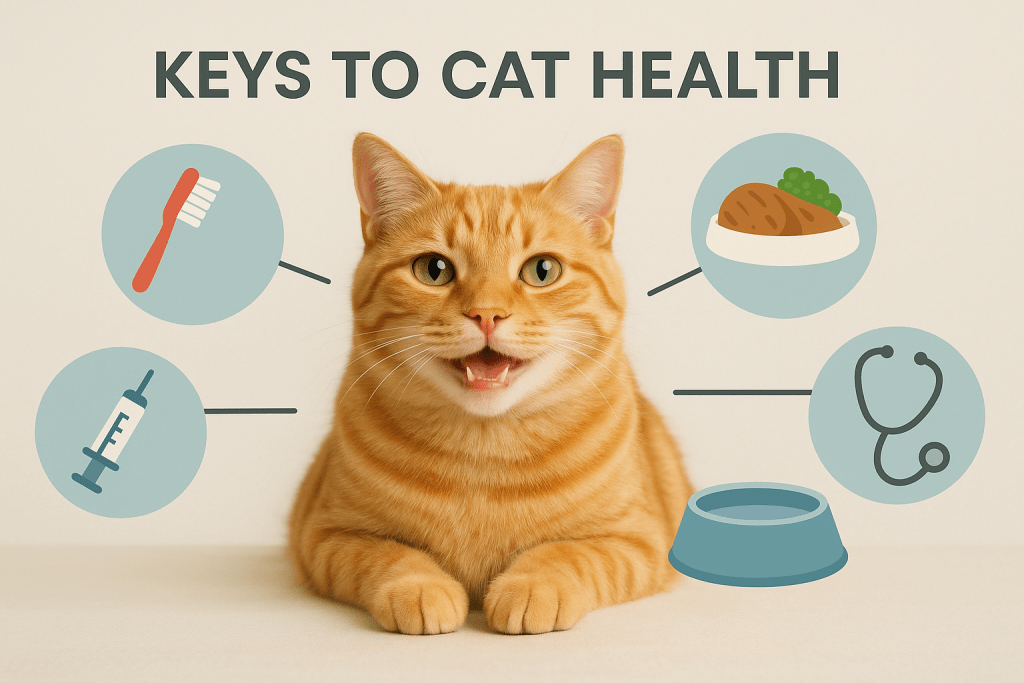
11 Common Diseases in Cats Every Owner Should Know
Cats are graceful, independent, and resilient creatures, but like every other living being, they face health challenges. The truth is, there are several common diseases that affect cats across different ages, lifestyles, and environments. Understanding these illnesses, their signs, and preventive care can help every cat parent ensure their furry friend lives a longer, healthier life.
List of Common Diseases in Cats:
- Dental disease
- Obesity
- Parasitic infestations
- Upper respiratory infection
- Kidney disease
- Feline immunodeficiency virus (FIV)
- Diabetes
- Feline leukemia
- Cancer
- Feline panleukopenia (feline distemper)
- Rabies
Dental Disease
Dental problems are among the most common diseases in cats. Studies from Cornell University show that between 50% and 90% of cats over four years old suffer from some form of dental issue.
The reason this happens is simple: bacteria and food particles accumulate on the teeth and gums. Without proper dental cleaning, this buildup leads to gingivitis, periodontal disease, and tooth resorption. Cats often hide pain, so owners might miss early signs. That’s why regular checkups, dental cleanings under anesthesia, and home dental care like brushing or dental treats play a major role in prevention.

Obesity
Obesity is another one of the common diseases that silently shortens a cat’s life. A cat is overweight when its body weight is 10–20% above ideal, and obese when it’s more than 20%.
The problem with excess weight isn’t just about appearance. It stresses joints, weakens the immune system, and raises the risk of diabetes, arthritis, and even heart disease. Cats gain weight mostly from overfeeding, high-calorie diets, and lack of activity. Maintaining portion control, encouraging play, and choosing nutrient-rich foods rather than calorie-dense treats helps cats stay lean.
Parasitic Infestations
Parasites are widespread and dangerous common diseases in cats. They can live inside or on the surface of the feline body, draining nutrition, damaging organs, and spreading other illnesses.
- Roundworms, Hookworms, Tapeworms – attack the intestines, leading to diarrhea, weight loss, or vomiting.
- Lungworms – invade the respiratory system, causing coughing or difficulty breathing.
- Heartworms – affect the heart and blood vessels, and in cats, even a few worms can be deadly.
Fleas and ticks are external parasites that not only cause itching but also transmit other diseases. Preventive medications, regular deworming, and flea control are essential.

Upper Respiratory Infections
Upper respiratory infections are common diseases that affect the nose, throat, and sinuses. Cats with URIs often sneeze, cough, and have watery eyes and nasal discharge.
These infections spread quickly, especially in multi-cat households or shelters. Most are caused by viruses like feline herpesvirus or calicivirus, while bacteria can worsen the condition. Though mild cases resolve with supportive care, severe cases can cause dehydration, loss of appetite, and even pneumonia. Vaccination reduces risk, but infected cats may remain lifelong carriers.
Kidney Disease
Kidney disease is one of the most common diseases in cats, particularly in older ones. The kidneys filter toxins, maintain hydration, and balance minerals. When they fail, toxins build up, leading to lethargy, vomiting, and weight loss.
The causes vary—genetics, infections, injuries, or simply aging. Since symptoms progress slowly, early detection through blood tests and urine analysis is crucial. While kidney disease cannot be cured, it can be managed with special diets, hydration support, and medication. Many cats with kidney disease live several years with a good quality of life if treated early.
Table: Signs of Kidney Disease vs Management
| Symptoms | Management Options |
| Increased thirst/urination | Prescription renal diet |
| Vomiting, weight loss | Anti-nausea medication |
| Lethargy | Fluid therapy (IV or subQ) |
Feline Immunodeficiency Virus (FIV)
FIV belongs to the category of common diseases in cats. It weakens the immune system, making cats vulnerable to infections and cancers.
FIV spreads mainly through deep bite wounds, which is why unneutered outdoor male cats face the highest risk. Not all infected cats show immediate illness; many live for years without major issues if kept indoors and monitored. Preventing fights and avoiding exposure are the best protective measures. Though no cure exists, supportive care allows FIV-positive cats to lead fulfilling lives.
Diabetes
Diabetes is another metabolic illness classified under common diseases in cats. Roughly one in 100 cats develops it, with obesity being the main risk factor.
- Type I – insulin deficiency, rare in cats.
- Type II – insulin resistance, the most common form.
Diabetic cats show signs such as excessive thirst, frequent urination, and weight loss despite eating normally. Treatment often includes insulin injections, diet control, and weight management. With proper care, diabetic cats can thrive for years.

Feline Leukemia Virus (FeLV)
FeLV is one of the deadliest common diseases in cats. It destroys white blood cells and weakens immunity, leaving cats exposed to secondary infections and cancers.
It spreads through saliva, grooming, or shared bowls, so cats living closely together are at risk. Unlike FIV, FeLV progresses faster, often leading to lymphoma or anemia. Vaccination offers strong protection, and early testing helps identify infected cats before they spread the virus to others.
Cancer
Cancer is a group of common diseases where abnormal cells multiply uncontrollably. In cats, 53–83% of tumors are malignant, meaning they spread to other parts of the body.
The most frequent types include lymphoma, squamous cell carcinoma, and mammary cancer. Warning signs range from lumps and swelling to unexplained weight loss or changes in behavior. Early detection gives the best chance for treatment—options include surgery, chemotherapy, or radiation. Outcomes depend on the type of cancer and how early it’s caught.
Feline Panleukopenia (Feline Distemper)
Panleukopenia, or feline distemper, is a viral illness that spreads rapidly among unvaccinated cats. It remains one of the deadliest common diseases in young kittens.
The virus attacks rapidly dividing cells in the bone marrow and intestines, causing severe diarrhea, dehydration, and immune system collapse. Vaccination is highly effective and considered core for all cats. Without it, mortality rates are extremely high, especially in kittens.
Rabies
Rabies is a fatal viral infection and one of the most feared common diseases in cats. It affects the brain and spinal cord, leading to neurological breakdown.
Transmission occurs through the bite of an infected animal. Once symptoms appear—aggression, disorientation, paralysis—there is no cure, and death is inevitable. Vaccination is not just recommended but legally required in many regions. Keeping cats indoors and vaccinated is the only true protection.

How to Prevent Common Diseases in Cats
While many common diseases sound frightening, prevention is achievable through responsible care:
- Routine vet visits for early detection.
- Vaccinations against rabies, FeLV, and panleukopenia.
- Regular parasite control.
- Balanced diet and weight management.
- Dental hygiene and annual cleanings.
- Keeping cats indoors reduces exposure.

FAQs About Common Diseases in Cats
1. What are the most common diseases in cats?
The most common diseases include dental disease, obesity, parasitic infestations, upper respiratory infections, kidney disease, diabetes, feline leukemia, and rabies.
2. How can I tell if my cat is sick?
Look for changes in eating, drinking, litter box habits, grooming, energy levels, and behavior. Vomiting, weight loss, or breathing issues are also warning signs.
3. Can common diseases in cats be prevented?
Yes. Vaccinations, regular vet visits, parasite control, dental care, and a balanced diet are the best preventive steps.
4. Do indoor cats get common diseases too?
Absolutely. Indoor cats are safer but can still suffer from dental problems, obesity, kidney disease, or even diabetes. Routine vet care remains essential.
5. When should I take my cat to the vet?
Any sudden change in appetite, weight, energy, or litter box habits warrants a vet visit. Early diagnosis of common diseases can save your cat’s life.
Final Thoughts
Cats depend on us to safeguard their health. From common diseases like dental issues and obesity to life-threatening ones like rabies and leukemia, awareness is the first step toward prevention. Regular checkups, a healthy lifestyle, and vaccinations can make all the difference.
If you’d like to learn more about other feline health issues, check out our detailed guide on Giardia in cats.
By staying alert and proactive, every cat parent can ensure their feline companion lives a long, healthy, and joyful life.

0 Comments